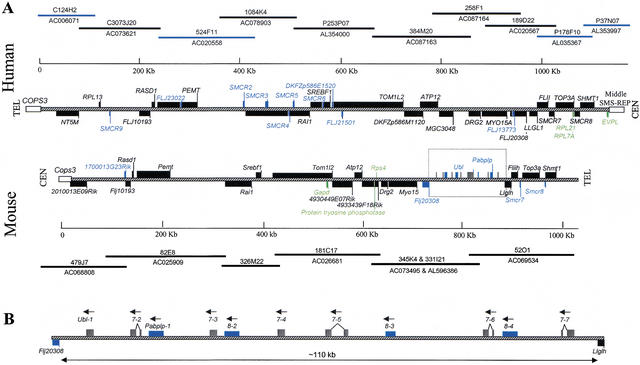Figure 4.
Transcript map of the SMCR and its mouse syntenic region. The BAC and PAC clones are identified by name and accession number. (A) Clones without a prefix are BACs from RPCI-11 (human) or from RPCI-23 (mouse); those with prefix P are PAC clones; those with prefix C are CTD clones. The hatched line represents the SMCR, and the open boxes represent the flanking sequences of the SMCR: COPS3 and the middle SMS-REP. The position 0 on the size scale is assigned to the nucleotide proximal to the putative promoter of the COPS3 gene. Genes inside SMCR are represented by black boxes, predicted genes by blue boxes, and pseudogenes by green boxes. The predicted genes Ubl and Pabplp are located between Flj20308 and Llglh, and both are present as a gene cluster. To distinguish from Pabplp, gray boxes were used to represent the Ubl. Human genes transcribed from centromere to telomere are located above the central line, and genes transcribed from telomere to centromere are below the line. The mouse genes are drawn in the reciprocal manner (i.e., genes transcribed from telomere to centromere are above the central line). (B) The structure of the ∼110-kb gene clusters between Flj20308 and Llghl that is boxed in A. Seven copies of Ubl and four copies of Pabplp are intermixed. Solid lines connecting exons represent the splicing pattern. All copies are potentially transcribed in the same direction (arrows). The Ubl gene appears to have four copies with spliced variants.

